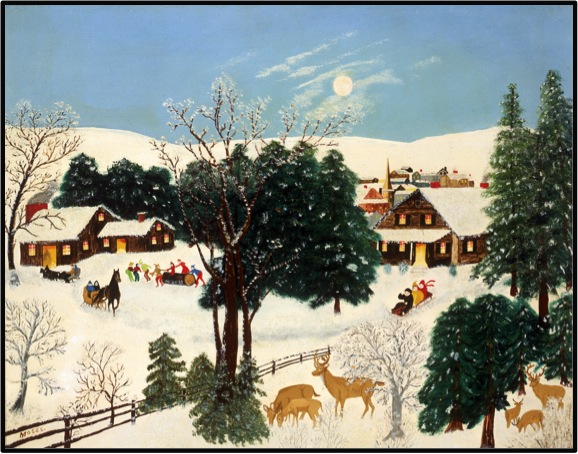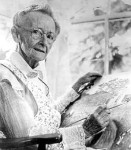
Grandma Moses
American, 1860-1961
Bringing in the Yule Log, 1949
oil on panel
18 x 23 in.
SBMA, Gift of Dwight and Winifred Vedder
2006.54.12

Grandma Moses busy at work
“What a strange thing is memory, and hope; one looks backward, the other forward; one is of today, the other of tomorrow. Memory is history recorded in our brain, memory is a painter, it paints pictures of the past and of the day."
". . . I look out the window sometimes to seek the color of the shadows and the different greens in the trees, but when I get ready to paint I just close my eyes and imagine a scene."
"I have written my life in small sketches, a little today, a little yesterday . . . I look back on my life a good day's work, it was done and I feel satisfied with it. I made the best out of what life offered."
"If I didn't start painting, I would have raised chickens."
"A primitive artist is an amateur those work sells."
- Grandma Moses
RESEARCH PAPER
Grandma Moses's life and memories reach from the day Lincoln died to the dawn of the Space Age - from 1860 to 1961. She was born Anna Mary Robertson on September 7, 1860, in the town of Easton near Greenwich, New York, one of 10 children of a farm family. She married Thomas Salmon Moses at 27, bore 10 children (5 died in infancy) and turned her full attention to art at 78. She died, with an unfinished painting on her easel, at age 101 on December 13, 1961.
Artistic Career
At 78 she began to paint when her arthritis made it difficult to continue making the yarn pictures that she liked. Her first picture was done with house paint and a piece of canvas left over from making a threshing machine cover. She would create more than 1500 paintings during her 23 year career. Her first works were put up for sale at the W. D. Thomas Pharmacy in Hoosick Falls, N.Y., where the small one brought $3.00 each and the large ones, $5.00. (The most she ever received for one painting was $1000 for the painting of President Eisenhower's Gettysburg home). At her first one-man show, at age 80, a New York reviewer dubbed her "Grandma" and the name and the artist became instantly and internationally popular.
1938 - the paintings exhibited in the Hoosick Falls pharmacy caught the eye of part-time art dealer, Lewis J. Caldor.
1939 - 3 of her paintings were included in a show of Contemporary Unknown American Painters at the Museum of Modern Art in New York.
1940 - first one-man show called "What a Farm Wife Painted" at the St. Etienne Gallery, N.Y.
1942 - one-man show at American/British Art Center in N.Y. At this time the director, Ala Story, began to take an interest in her.
1940's - Her work was exhibited in European capitals; reproduced on Christmas cards, textiles, and china.
1949 - she was a guest at the White House where President Truman gave her an award for "outstanding accomplishment."
1950 - she was the subject of a documentary film.
1952 - she published her autobiography, Grandma Moses, My Llfe's History .
GRANDMA MOSES'S WORK IN RELATION TO THE ART OF THE PERIOD
Lewis J. Caldor, the New York art collector who discovered her, was initially told that her work was "nice" but unimportant and not in line with contemporary art. What accounts for her subsequent fame? Two reasons are advanced: nostalgia and the popularity of primitive and folk art. The nostalgia was for the "old days" of a bygone halcyon era - an escape from the horrors of two World Wars and from Cold War bomb shelters. The esteem for the "primitive" in art dates from the Parisian cubists and their enthusiasm for Henri Rousseau which peaked in the 1940's. Grandma Moses was the beneficiary of a revival of a popular folk art tradition.
While the majority of Grandma Moses's landscapes are static and show Nature in a mood of undisturbed peace, she also did a number in which nature is in a state of turmoil. A disturbance in the atmosphere is generally represented by windblown trees bending under a gale and by a sky dark with menacing clouds.
Typically her colors are bright and serene and her subject matter radiates perfect harmony. (She would not consider "disagreeable and troublesome subjects") She loved color and used it to give her pictures an abundance of life, freshness, and radiance. She did not regard gloomy colors as the "right thing" for an artist.
In many of her paintings, trees play an important role. She loved them especially and carefully observed their various shapes and tones.
Animals are seldom stereotyped as are the human figures. Rarely did she copy them. Human figures in her work are for the most part stock types who perform standard chores and such figures were taken from books, old prints or newspaper clippings which explain their recurrence in her paintings. The animals are painted with natural ease and abandon, with the emphasis not on details of their appearance but on their movements which are astonishingly well observed.
The Painting
Technique: Grandma Moses's Step by step Painting Technique
1. She covered masonite panels with a layer of white paint. (White underpaint gives the clear luminous quality to the colors applied later) She preferred masonite because "it will lest many years longer than canvas." She usually prepared several panels at a time.
2. She did very little preliminary sketching, but did plan the composition carefully, drawing the main outlines and indications of details before starting to paint. She drew a thin pencil mark to fix "how far down the sky will reach." The wavy pencil outline also indicated the hills that would be painted below.
3. First, she painted the sky.
4. She then drew the main objects with a few rough strokes: hills, houses, trees. But no details whatsoever; they were all put in with the paint brush. This method explains why her pictures appear so fresh and spontaneous - almost improvised.
5. She played with her theme and invented details as she went along.
She worked indoors
Grandma Moses was a careful observer of nature; however, she never worked outdoors. That notion never occurred to her; in fact, she considered it "very impracticable." She preferred an upstairs room in her home, painting with "it all up here in my head." The light from a 150 watt bulb enabled her to paint at all times of the day and on the darkest days of winter.
Loving attention to detail
The pleasure she took in making a picture, the playful imagination that went into the making of each little detail, can be sensed in the finished works. She sometimes used a match or even a pin to put in the eyes and the mouth "because the brushes are not fine enough."
Hallmarks of her style
- simplicity and candor. She expresses what she has to say in a clear uncomplicated manner.
- specificity. One feels that what she tried to express was always a personal experience. She doesn't romanticize or sentimentalize.
- a genius for color. She commands the pictorial space largely through the medium of color.
- childlike drawing. Her drawing, especially of figures, is childlike.
- evokes atmosphere and creates lively animated scenes.
- the hues of her palette are those of nature, but intensified by her imagination and applied with a stunning sense of design.
In summary, artistically her paintings combine masterly landscape painting with "primitive," i.e., crudely drawn, figures. These elements, seemingly at great variance with each other, blend to natural harmony. Together they constitute what has become known as the Grandma Moses style.
IS GRANDMA MOSES A "PRIMITIVE ARTIST"?
Characteristics of "primitive art": (from Kallir, Grandma Moses. American Primitive , p. 17)
- self-taught
- crude and childlike appearance
- inadequacy in depicting human figures
- scant knowledge of perspective; features flat patterns rather than depth because the artist has not mastered rules of perspective
- illustrative and decorative quality
- often reproduce events from artist's own life
- appears spontaneous and close to nature
- an instinctive sense of color and composition
Grandma Moses has often been called a "primitive artist" - a term applied to those with no professional training. However, one should not confuse "self-taught" with "primitive." Two expert opinions (Otto Kallir, and Sidney Janis) agree that she should be classified "natural" or "self-taught." ("Primitive" does not equal "self-taught." The style of a self-taught artist need not differ from that of a professional, whereas the character of a primitive work is always distinctly set apart from professional art.) Grandma Moses was certainly self-taught. She never attended an art class; she never visited a museum. Her only artistic inspirations - apart from Nature - were illustrated school books, Christmas cards, 19th century color prints, and magazine and newspaper illustrations.
It is only in her treatment of figures that she can be classified as "primitive." She used figures only as accessories, to advance the narrative. Whereas she painted landscapes, she played with figures and they are often awkward. Her landscapes are far from primitive; they are highly individual representations of nature, testifying to an extraordinary sensitivity to color and mood. Here her technique is better compared to that of the Impressionists than to the Primitives, whose style is generally flat and decorative. Few primitive artists achieve her luminosity of color and almost none can match her in creating an illusion of deep space. In her work, nothing is stylized, nothing is meant to be decorative. She paints mountains in large, flowing brush strokes, evoking an impression of distance by the use of dark and light tints, thus achieving the effect of depth without theoretical knowledge of perspective.
Grandma Moses and Ala Story
Grandma Moses credited Ala Story as a key role in her artistic life. "....thanks to Mr. Louis Caldor, Mr. Otto Kallir and Ala Story, through those, life has been a success." (Grandma Moses, 1947)
1942 - Ala Story began to take an interest in Grandma Moses. Ala Story was then director of the American-British Art Center in New York
1946 - Otto Kallir wrote that Ala Story shared his conviction of the artist's importance and they began making plans for a documentary film. The award winning film was completed in 1950.
Between 1943 and 1950, Grandma Moses created about 20 very large paintings measuring up to 36"x18". She was encouraged to venture into this format by Ala Story who sent her 2 large canvases in the summer of 1943 and suggested she paint 2 winter scenes. During the following years, Ala Story sent her more large canvases. (from Otto Kallir, Grandma Moses. p. 105, 233)
Bibliography on file in the docent office
Original research prepared for the SBMA Docent Council by Faith Henkin, April 1988, for another painting by Grandma Moses, A STORM IS ON THE WATERS NOW, 1947, Oil on composition board, Loan #L.1986.3.4
Edited March 2007 from a SBMA Docent Research Paper on file. LG
